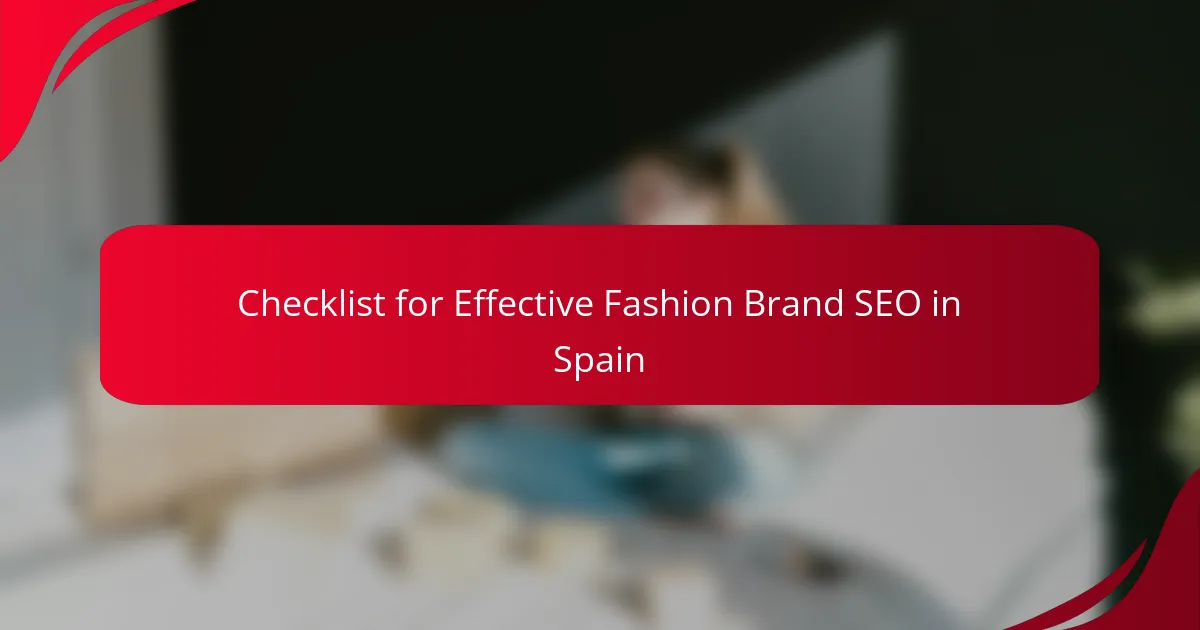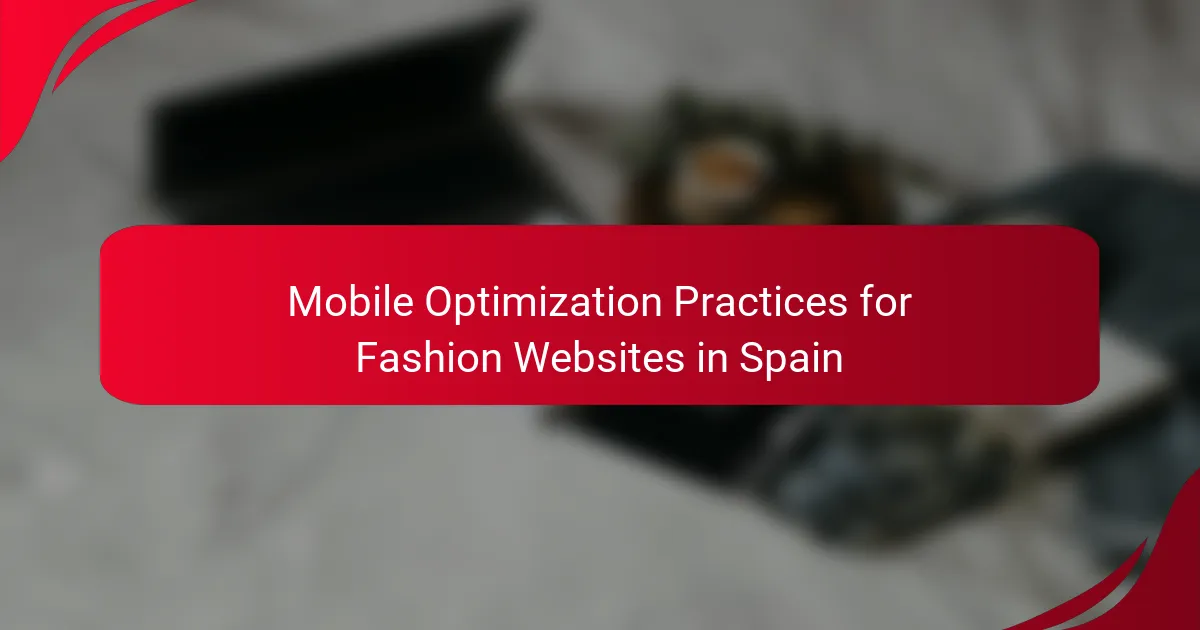Social media advertising strategies are essential for Spanish fashion brands looking to thrive in a competitive landscape. By leveraging influencer partnerships, targeted campaigns, and engaging content, these brands can effectively connect with their audience and boost sales. Platforms like Instagram and Facebook offer unique opportunities to enhance visibility and foster customer engagement through visual storytelling and advanced targeting techniques.
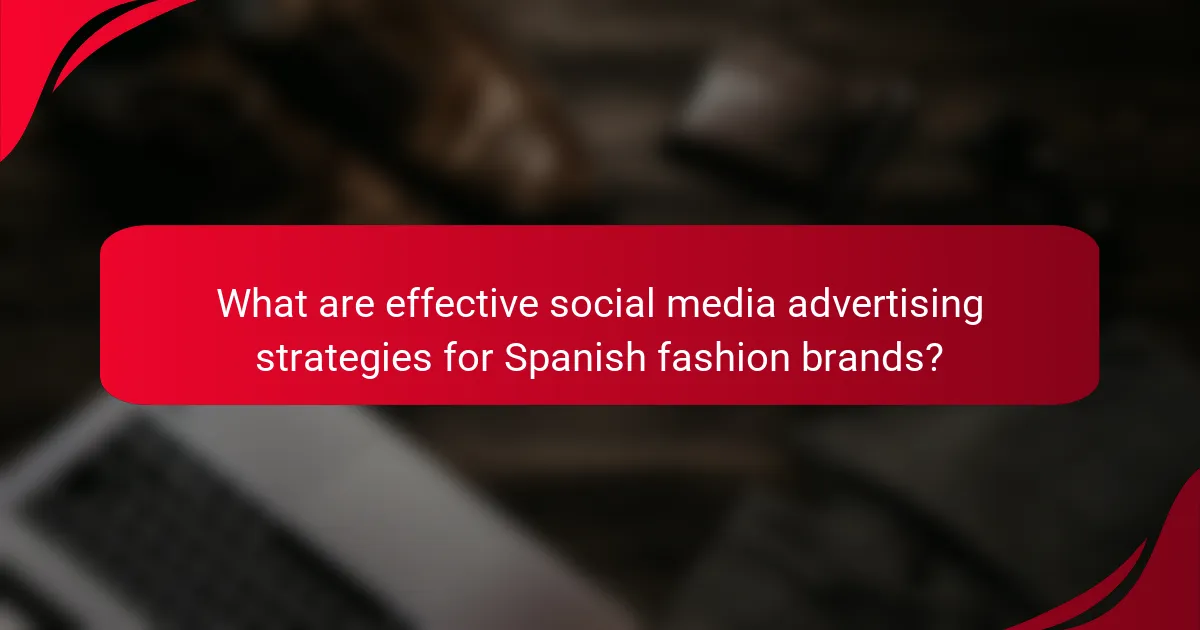
What are effective social media advertising strategies for Spanish fashion brands?
Effective social media advertising strategies for Spanish fashion brands include leveraging influencer partnerships, targeted ad campaigns, content marketing, visual storytelling, and user-generated content. These approaches help brands connect with their audience, enhance visibility, and drive sales in a competitive market.
Influencer partnerships
Collaborating with influencers can significantly amplify a Spanish fashion brand’s reach. By selecting influencers who resonate with the brand’s aesthetic and target audience, companies can create authentic endorsements that drive engagement. Consider micro-influencers, who often have higher engagement rates and more niche followings.
When establishing partnerships, ensure that the influencer’s values align with your brand’s image. Clear communication about expectations and deliverables is crucial for a successful collaboration.
Targeted ad campaigns
Targeted ad campaigns allow Spanish fashion brands to reach specific demographics effectively. Utilizing platforms like Facebook and Instagram, brands can tailor their ads based on age, location, interests, and shopping behaviors. This precision helps maximize ad spend and improve conversion rates.
Regularly analyze campaign performance metrics to refine targeting strategies. A/B testing different ad creatives can also reveal what resonates best with your audience, leading to more effective campaigns over time.
Content marketing
Content marketing focuses on creating valuable and relevant content to attract and engage potential customers. For Spanish fashion brands, this can include blog posts about fashion trends, styling tips, or behind-the-scenes looks at the design process. Engaging content builds brand loyalty and encourages sharing.
Incorporate SEO best practices to enhance visibility in search engines. Use keywords relevant to the Spanish fashion market, and consider localizing content to appeal to specific regional audiences.
Visual storytelling
Visual storytelling is essential for Spanish fashion brands, as fashion is inherently visual. High-quality images and videos can showcase products in a way that resonates emotionally with consumers. Use platforms like Instagram and Pinterest to share visually compelling narratives that highlight the brand’s identity.
Consider creating lookbooks or video content that tells a story about the collection or brand ethos. This approach not only showcases products but also connects with customers on a deeper level.
User-generated content
User-generated content (UGC) encourages customers to share their experiences with your brand, creating authentic endorsements. Spanish fashion brands can incentivize UGC by hosting contests or featuring customer photos on their social media channels. This not only builds community but also provides social proof.
Make it easy for customers to share their content by creating branded hashtags. Regularly engage with UGC by liking, commenting, or reposting, which fosters a sense of belonging among your audience and enhances brand loyalty.
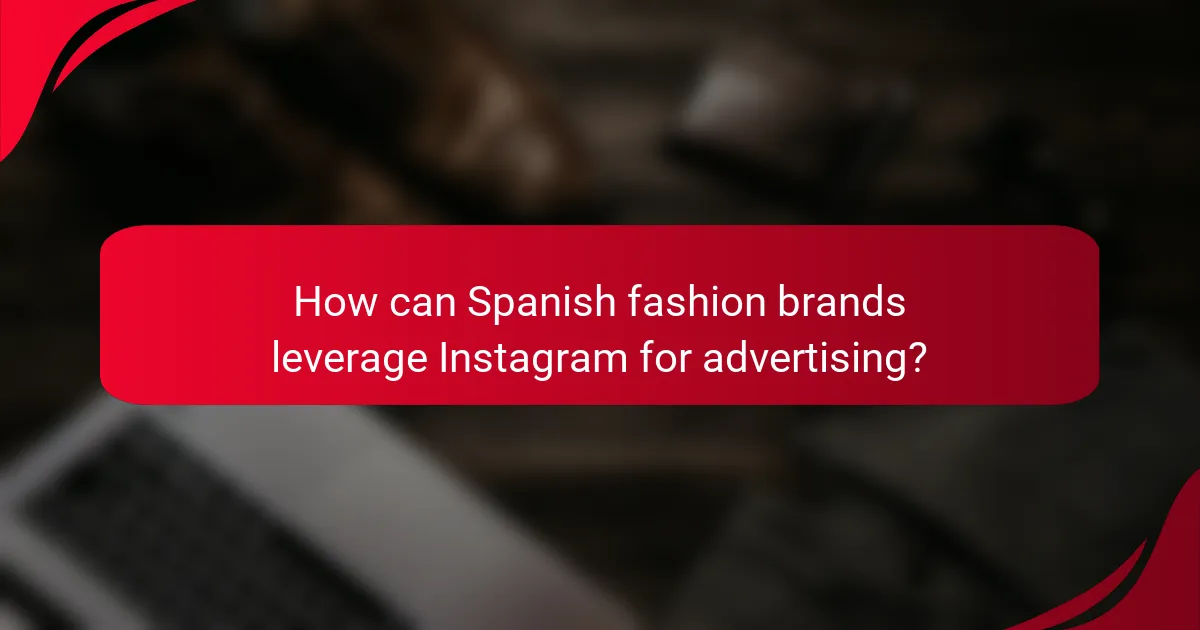
How can Spanish fashion brands leverage Instagram for advertising?
Spanish fashion brands can effectively use Instagram for advertising by utilizing its visual-centric features to engage audiences and drive sales. By focusing on shoppable posts, Instagram Stories ads, and Reels, brands can enhance their visibility and connect with potential customers in a dynamic way.
Shoppable posts
Shoppable posts allow Spanish fashion brands to tag products directly in their images, making it easy for users to purchase items without leaving the app. This feature streamlines the shopping experience and can significantly boost conversion rates.
To maximize effectiveness, brands should ensure high-quality visuals and compelling captions that highlight product benefits. Regularly updating shoppable content with seasonal collections or limited-time offers can create urgency and encourage purchases.
Instagram Stories ads
Instagram Stories ads provide a full-screen, immersive experience that captures users’ attention. These ads can be used to showcase new collections, promotions, or behind-the-scenes content, making them ideal for engaging audiences.
Brands should consider using interactive elements like polls or questions in their Stories ads to foster engagement. Keeping the content fresh and authentic is key; aim for a mix of polished and candid moments to resonate with followers.
Reels for brand awareness
Reels are short, engaging videos that can help Spanish fashion brands increase brand awareness and reach new audiences. By creating entertaining and informative content, brands can showcase their personality and style in a way that resonates with viewers.
To leverage Reels effectively, brands should focus on trends and challenges relevant to their audience. Consistency in posting and collaborating with influencers can further amplify reach and engagement, driving more traffic to their profiles and websites.

What are the best practices for Facebook advertising in the fashion industry?
Effective Facebook advertising for fashion brands involves understanding your audience, creating compelling content, and utilizing advanced targeting techniques. By focusing on these key areas, brands can enhance their visibility and engagement on the platform.
Audience segmentation
Audience segmentation is crucial for tailoring your Facebook ads to specific groups within the fashion market. By dividing your audience based on demographics, interests, and shopping behaviors, you can create more relevant ads that resonate with each segment.
Consider using Facebook’s Audience Insights tool to gather data on your target demographics. This can help you identify key characteristics such as age, location, and purchasing habits, enabling you to craft personalized messages that appeal to each group.
Retargeting strategies
Retargeting strategies allow fashion brands to reconnect with users who have previously interacted with their content or visited their website. This approach can significantly increase conversion rates by reminding potential customers of products they showed interest in.
Utilize Facebook’s Custom Audiences feature to create retargeting campaigns. For example, you can target users who added items to their cart but did not complete the purchase, offering them a discount or highlighting similar products to encourage them to finalize their transaction.
Engaging ad creatives
Engaging ad creatives are essential for capturing attention in the competitive fashion industry. High-quality images, videos, and compelling copy can make your ads stand out in users’ feeds.
Consider using lifestyle imagery that showcases your products in real-life scenarios, as this can help potential customers envision themselves wearing your fashion items. Additionally, incorporating user-generated content can enhance authenticity and trust, making your ads more relatable.
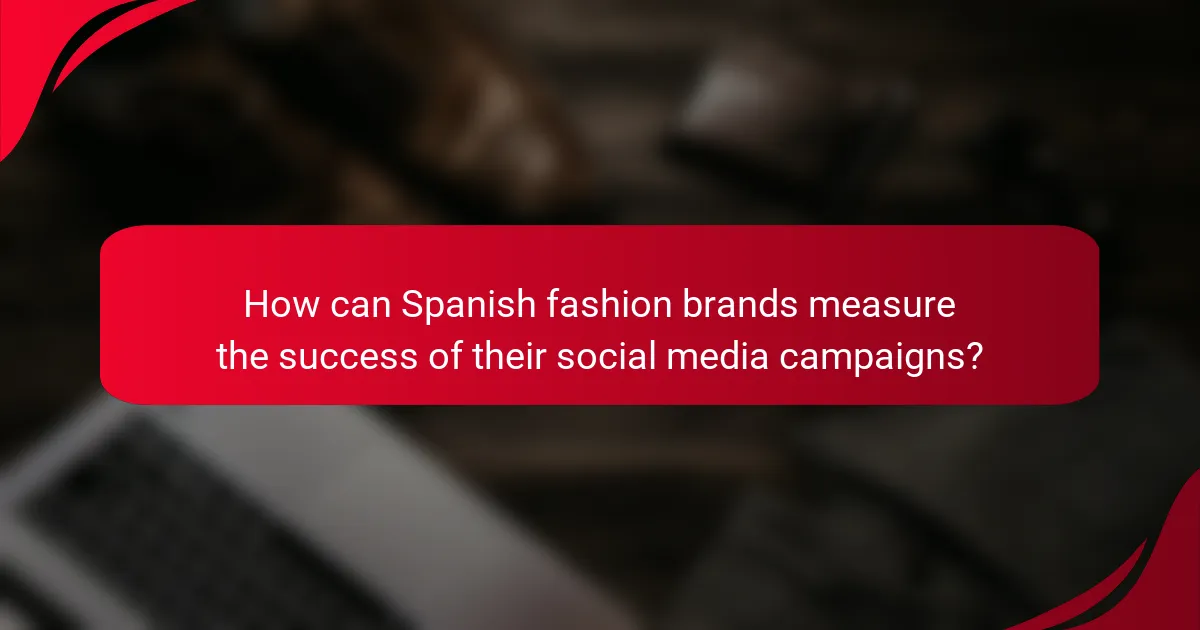
How can Spanish fashion brands measure the success of their social media campaigns?
Spanish fashion brands can measure the success of their social media campaigns by analyzing key performance indicators (KPIs), utilizing analytics tools, and gathering customer feedback. These methods provide insights into engagement, reach, and overall effectiveness of advertising efforts.
Key performance indicators
Key performance indicators are essential metrics that help Spanish fashion brands assess their social media campaign success. Common KPIs include engagement rates, click-through rates, conversion rates, and follower growth. Monitoring these indicators allows brands to identify trends and make data-driven decisions.
For instance, a fashion brand may aim for an engagement rate of 3-5% on Instagram posts, indicating that their content resonates well with the audience. Tracking these metrics over time can reveal which strategies are most effective.
Analytics tools
Analytics tools are crucial for Spanish fashion brands to gain deeper insights into their social media performance. Platforms like Google Analytics, Facebook Insights, and Instagram Analytics provide valuable data on user behavior, demographics, and campaign performance. These tools can help brands understand which content drives traffic and conversions.
Brands should regularly review these analytics to adjust their strategies. For example, if a specific type of post generates higher engagement, brands can create more similar content to capitalize on that interest.
Customer feedback
Customer feedback is a vital component of measuring social media campaign success for Spanish fashion brands. Engaging with customers through comments, direct messages, and surveys can provide qualitative insights into their perceptions and preferences. This feedback helps brands refine their messaging and product offerings.
Brands can encourage feedback by running polls on social media or asking followers to share their thoughts on recent campaigns. This direct interaction not only improves customer relationships but also informs future marketing strategies.
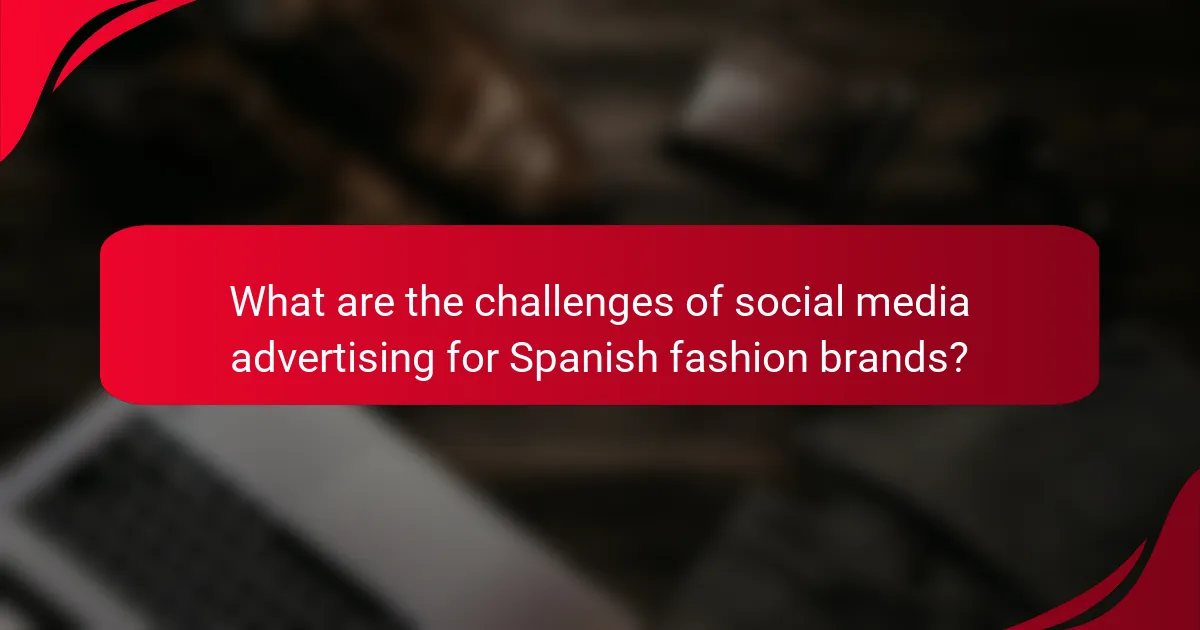
What are the challenges of social media advertising for Spanish fashion brands?
Spanish fashion brands face several challenges in social media advertising, including market saturation, evolving algorithms, and the need for brand differentiation. These factors can complicate efforts to effectively reach and engage target audiences.
Market saturation
The fashion industry in Spain is highly competitive, with numerous brands vying for consumer attention on social media. This saturation makes it difficult for individual brands to stand out and capture the interest of potential customers.
To navigate this challenge, brands should focus on niche markets or unique selling propositions (USPs) that resonate with their target demographic. For example, emphasizing sustainable practices or local craftsmanship can help differentiate a brand in a crowded marketplace.
Changing algorithms
Social media platforms frequently update their algorithms, impacting how content is displayed to users. These changes can affect the visibility of posts, making it essential for Spanish fashion brands to stay informed and adapt their strategies accordingly.
Brands should regularly analyze engagement metrics and adjust their content types, posting times, and promotional strategies to align with the latest algorithm trends. Utilizing a mix of organic and paid advertising can also help maintain visibility amidst algorithm shifts.
Brand differentiation
Establishing a distinct brand identity is crucial for Spanish fashion brands to succeed in social media advertising. With many brands offering similar products, it is vital to communicate a unique narrative that resonates with consumers.
Brands can achieve differentiation by developing a strong visual identity and consistent messaging across platforms. Engaging storytelling, influencer partnerships, and user-generated content can further enhance brand recognition and loyalty.
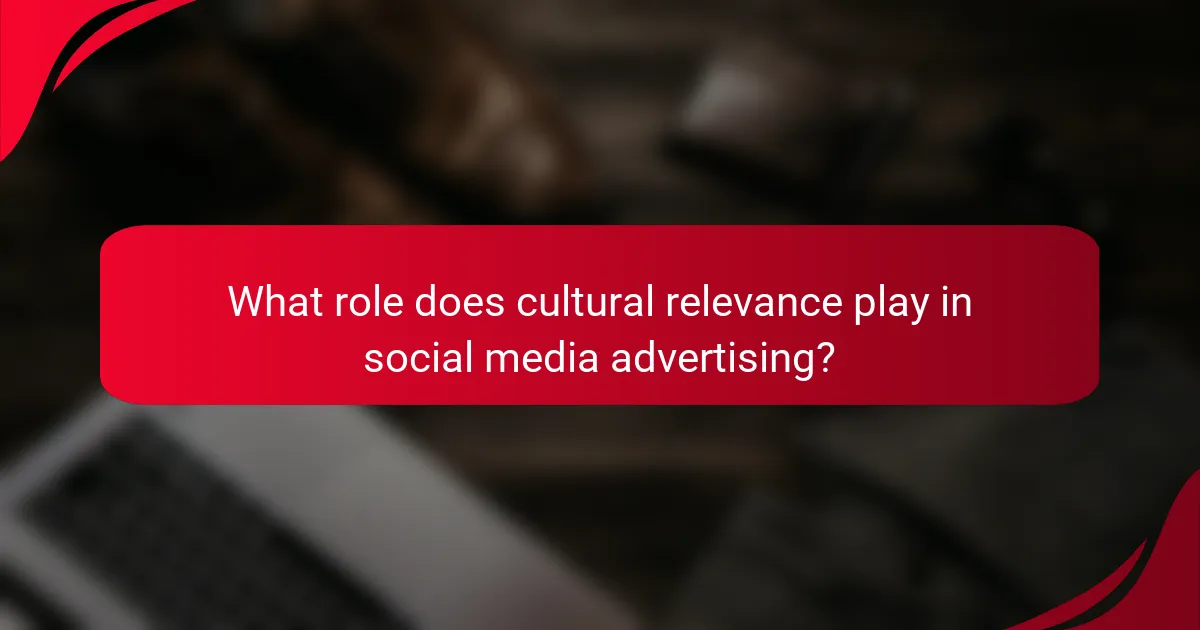
What role does cultural relevance play in social media advertising?
Cultural relevance is crucial in social media advertising as it ensures that content resonates with the target audience’s values, traditions, and preferences. For Spanish fashion brands, aligning marketing messages with local culture can enhance engagement and brand loyalty.
Localized content
Localized content involves tailoring advertising materials to reflect the cultural nuances and language of the target market. For Spanish fashion brands, this means using Spanish language and incorporating local customs, holidays, and trends in their campaigns.
When creating localized content, consider using regional dialects or slang that appeal to specific demographics. For instance, a campaign targeting younger audiences in Madrid may use contemporary slang, while one aimed at older consumers in Andalusia might incorporate more traditional expressions.
Additionally, leveraging local influencers can amplify the impact of localized content. Collaborating with influencers who understand and embody the local culture can enhance authenticity and trust, making the brand more relatable to the audience.







